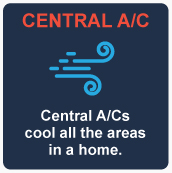How to Pick Between Central A/C and Ductless Air Conditioning
While temperatures in the Pacific Northwest are generally mild throughout the year, there are days in which the heat seems unbearable. Installing a new A/C is a step in the right direction toward achieving total home comfort. As you research your options, you’ll find that ductless air conditioning and central air conditioning systems are among the most popular choices. Knowing the difference between the two will help you make an education decision regarding the type of A/C unit that best meets your budget and home comfort needs.
Central Air Conditioning vs. Ductless Air Conditioning
Central A/C
A central A/C conditions air from a central unit. The system distributes air to and from spaces through ductwork using fans. Supply ducts carry the conditioned air, where it enters spaces via registers. After the air circulates and becomes warmer, return ducts and registers carry it back to the A/C unit.
Central air conditioning is great if you want to “set it and forget it,” as the unit will cycle on and off throughout the day. Pairing the system with a programmable thermostat will reduce energy costs as the device will automatically raise and lower the temperature at set times.
Advantages
- Central A/Cs cool all the areas in a home.

- With the exception of the outdoor condenser unit and slim registers, central A/C units are almost invisible.
- A unit might add value to your home.
- If a home has existing ductwork, a central A/C unit might be simple for a professional to install.
- Depending on your home’s configuration, you may setup different zones that allow you to control the temperature in different areas.
- Central A/Cs tend to have longer warranty periods than ductless units.
Disadvantages
- Ductwork needs to be cleaned.
- Ductwork can tear and may need replacing every decade.
- If the home does not have ductwork, installation costs can be twice as much as a ductless A/C system with the same capacity. A contractor will need to remove the walls and parts of the ceiling to install the ducts. A specialist will then patch and paint the walls.
- Depending on the home’s configuration, the ducts and indoor unit can take up a lot of space in closets, attics, crawlspaces or basements.
- If your home has ductwork, a contractor may need to design a new system and install new ducts.
- If a duct leaks, conditioned air will enter unoccupied spaces that may not need to be cooled (i.e., the attic) and waste energy.
- Without zoning, all the spaces in your home will be the same temperature.
- Dirty ducts can negatively impact the quality of air in your home.
Ductless A/C
A ductless air conditioner, or ductless mini-split system, uses an outdoor compressor and indoor handling units in the spaces you want to cool. Instead of ductwork, a small conduit connects the components. During installation, a contractor places the indoor units in the rooms you desire and drills holes in the walls for the conduit, which has a power cable, condensate drain and refrigerant line that runs to the outdoor unit. In addition to cooling the air, during the winter, a ductless unit absorbs heat from the air outside and moves it indoors to warm your home.
Ductless A/C units are a good choice for older buildings that do not have space for ductwork. They may also be ideal for homeowners who don’t want to install ductwork.
Advantages
- Because you place several indoor handling units throughout a home, you do not have to cool empty rooms.

- The units maintain a constant temperature as they don’t cycle on and off.
- The system tends to be quieter than central A/C systems.
- Some models have the highest efficiency ratings of all A/C systems available, particularly if they have variable-speed air handlers.
- The units are fast and simple for professionals to install in homes without ductwork.
- If a home has ductwork, you can still install a ductless A/C.
- The system’s zoning capabilities allow family members and guests to set the temperature they prefer in their rooms.
- You can often control the system with a remote control.
- You can use ductless units to supplement a central A/C, which is beneficial when you want to cool a new space, like an addition.
Disadvantages
- Indoor units hang on walls or occupy space on the floor, which may look unattractive without a cover.
- Ductless systems have greater upfront costs than central A/C units.
The best way to determine if a central air conditioning or ductless air conditioning system is best for you is to schedule a consultation with an expert from AAA Heating and Cooling. Based on the information learned, they’ll create a custom plan that fits your expectations and budget. Call to schedule an appointment today.